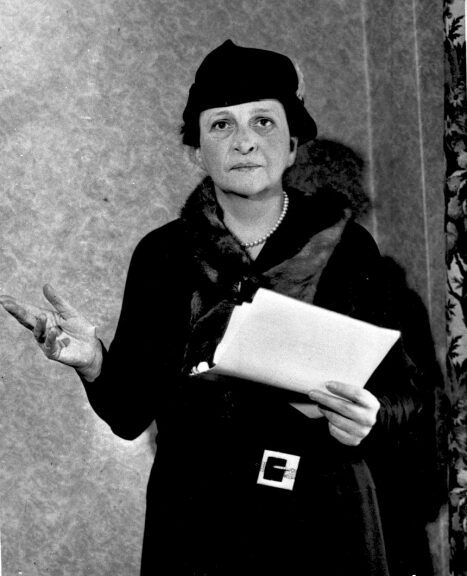FRANCES PERKINS, who died on this date, was an American workers-rights advocate who served as the 4th United States secretary of labor from 1933 to 1945, the longest serving in that position. A member of the Democratic Party, Perkins made history as the first woman ever to serve in a presidential cabinet. As a loyal supporter of her longtime friend, Franklin D. Roosevelt, she helped make labor issues important in the emerging New Deal coalition. She was one of two Roosevelt cabinet members to remain in office for his entire presidency (the other being Interior Secretary Harold L. Ickes).
Her most important role came in developing a policy for social security in 1935. She also helped form government policy for working with labor unions, although the union leaders distrusted her. Her Labor Department helped to mediate strikes by way of the United States Conciliation Service. Perkins dealt with many labor questions during World War II, when skilled labor was vital to the economy and women were moving into jobs formerly held by men.
In 1933, Roosevelt summoned Perkins to ask her to join his cabinet. Perkins presented Roosevelt with a long list of labor programs for which she would fight, from Social Security to minimum wage. “Nothing like this has ever been done in the United States before,” she told Roosevelt. “You know that, don’t you?” Agreeing to back her, Roosevelt nominated Perkins as Secretary of Labor. The nomination was met with support from the National League of Women Voters and the Women’s Party. The American Federation of Labor criticized the selection of Perkins because of a perceived lack of ties to labor.
As secretary, Perkins oversaw the Department of Labor. Perkins went on to hold the position for twelve years, longer than any other Secretary of Labor. She also became the first woman to hold a cabinet position in the United States, thus she became the first woman to enter the presidential line of succession. The selection of a woman to the cabinet had been rumored in the four previous administrations, with Roosevelt being the first to follow through. Roosevelt had witnessed Perkins’s work firsthand during their time in Albany. With few exceptions, President Roosevelt consistently supported the goals and programs of Secretary Perkins.
As Secretary of Labor, Perkins played a role in the New Deal by helping to write legislation. As chair of the President’s Committee on Economic Security, she was involved in all aspects of its advisory reports, including the Civilian Conservation Corps and the She-She-She Camps. Her most important contribution was to help design the Social Security Act of 1935.
In 1939, she came under fire from some members of Congress for refusing to deport the communist head of the West Coast International Longshore and Warehouse Union, Harry Bridges. Ultimately, Bridges was vindicated by the Supreme Court.
With the death of President Roosevelt, Harry Truman replaced the Roosevelt cabinet, naming Lewis B. Schwellenbach as Secretary of Labor. Perkins’s tenure as secretary ended on June 30, 1945, with the swearing in of Schwellenbach.
In 1913, Perkins married New York economist Paul Caldwell Wilson. She kept her maiden name because she did not want her activities in Albany and New York City to affect the career of her husband, then the secretary to the New York City mayor. She defended her right to keep her maiden name in court. The couple had a daughter, Susanna, born in December 1916. Less than two years later, Wilson began to show signs of mental illness. He would be institutionalized frequently for mental illness throughout the remainder of their marriage. Perkins had cut back slightly on her public life following the birth of her daughter, but returned after her husband’s illness to provide for her family.
In James Kirchick’s recent, estimable history of gay Washington D.C. Secrest City: The Hidden History of Washington D.C. he reports that Perkins’s biographer, Kirsten Downey, wrote that “while it is probably impossible to know whether Perkins’s relationship with Junior League founder Mary Harriman Rumsey was sexual or romantic …it was much more than an ordinary friendship.” The two women lived, vacationed, entertained and raised puppies together, all hallmarks of a “Boston marriage,” a term used to describe the cohabitation of two, usually wealthy women during the late 19th and early 20th centuries.
